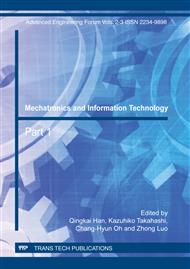[1]
R. Aaslid, T.M. Markwalder, H. Nornes, Noninvasive transcranial doppler ultrasound recording of flow velocity in basal cerebral arteries, J. Neurosurg. 57(1982) 769– 774.
DOI: 10.3171/jns.1982.57.6.0769
Google Scholar
[2]
J.E. Peltonen, J.M. Kowalchuk, D.H. Paterson, D.S. DeLorey, G.R. duManoir, R.J. Petrella, J.K. Shoemaker, Cerebral and muscle tissue oxygenation in acute hypoxic ventilatory response test,Respiratory Physiology & Neurobiology. 155 (2007) 71–81.
DOI: 10.1016/j.resp.2006.03.008
Google Scholar
[3]
H.H. Van, P. Poommipanit, M. Shalaby, R. Gevorgyan, C.H. Tseng, J. Tobis, Sensitivity of transcranial doppler versus intracardiac echocardiography in the detection of right-to-left shunt, Cardiovascular Imaging. 4 (2010) 343-348.
DOI: 10.1016/j.jcmg.2009.12.012
Google Scholar
[4]
R.G. Wise, K. Ide, M.J. Poulin, I. Tracey, Resting fluctuations in arterial carbon dioxide induce significant low frequency variations in BOLD signal, NeuroImage. 21 (2004) 1652– 1664.
DOI: 10.1016/j.neuroimage.2003.11.025
Google Scholar
[5]
G. Vingerhoets, E. Luppens, Cerebral blood flow velocity changes during dichotic listening with directed or divided attention: a transcranial doppler ultrasonography study, Neuropsychologia. 39 (2001) 1105–1111.
DOI: 10.1016/s0028-3932(01)00030-6
Google Scholar
[6]
B.A. Frauenfelder, D. Schuepbach, R.W. Baumgartner, D. Hell, Specific alterations of cerebral hemodynamics during a planning task: a transcranial Doppler sonography study, NeuroImage. 22 (2004) 1223–1230.
DOI: 10.1016/j.neuroimage.2004.03.008
Google Scholar
[7]
C. Schnittger, S. Johannes, A. Arnavaz, T.F. Munte, Blood flow velocity changes in the middle cerebral artery induced by processing of hierarchical visual stimuli, Neuropsychologia. 8 (1997) 1181-1184.
DOI: 10.1016/s0028-3932(97)00038-9
Google Scholar
[8]
N. Rhodes, D. Brown, A. Edison, Approaches to understanding young driver risk taking, J. Safety Research-Traffic Records Forum proceedings. 36 (2005) 497-499.
DOI: 10.1016/j.jsr.2005.10.012
Google Scholar
[9]
G. Yang, Y.Z. Lin, B. Prabir, A driver fatigue recognition model based on information fusion and dynamic Bayesian network, Information Sciences. 180 (2010) 1942–(1954).
DOI: 10.1016/j.ins.2010.01.011
Google Scholar
[10]
J. Wang, W. Xu, Y. Gong, Real-time driving danger-level prediction, Engineering Applications of Artificial Intelligence. 23 (2010) 1247–1254.
DOI: 10.1016/j.engappai.2010.01.001
Google Scholar
[11]
P.J. Cohen, S.C. Alexander, T.C. Smith, M. Reivich, H. Wollman, Effects of hypoxia and normocarbia on cerebral blood flow and metabolism in conscious man, J. Appl. Physiol. 23 (1067) 183–189.
DOI: 10.1152/jappl.1967.23.2.183
Google Scholar
[12]
J.B. Jensen, B. Sperling, J.W. Severinghaus, N.A. Lassen, Augmented hypoxic cerebral vasodilation in men during 5 days at 3, 810m altitude, J. Appl. Physiol. 80 (1996) 1214–1218.
DOI: 10.1152/jappl.1996.80.4.1214
Google Scholar
[13]
J.C. Kolb, P.N. Ainslie, K. Ide, M.J. Poulin, Protocol to measure acute cerebrovascular and ventilatory responses to isocapnic hypoxia in humans, Respir. Physiol. Neurobiol. 141 (2004) 191–199.
DOI: 10.1016/j.resp.2004.04.014
Google Scholar
[14]
S. Fritz, L. Chaitow, G.M. Hymel, Massage Application Assessment for Physical Healing and Rehabilitation, in: Clinical Massage in the Healthcare Setting, Elsevier Inc., Mosby, 2001, pp.248-313.
DOI: 10.1016/b978-032303996-3.50016-7
Google Scholar


